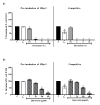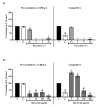Newer insights into the mechanism of action of Psidium guajava L. leaves in infectious diarrhoea
- PMID: 20584265
- PMCID: PMC2911405
- DOI: 10.1186/1472-6882-10-33
Newer insights into the mechanism of action of Psidium guajava L. leaves in infectious diarrhoea
Abstract
Background: Psidium guajava L., Myrtaceae, is used widely in traditional medicine for the treatment of diarrhoea, dysentery, gastroenteritis, stomachaches, and indigestion. However, the effect of the leaf extract of P. guajava on the pathogenesis of infectious diarrhoea has not been studied. The present study evaluates the effect of a hot aqueous extract (decoction) of dried leaves of P. guajava on parameters associated with pathogenicity of infectious diarrhoea. The aim was to understand its possible mechanism(s) of action in controlling infectious diarrhoea and compare it with quercetin, one of the most reported active constituents of P. guajava with antidiarrhoeal activity.
Methods: The crude decoction and quercetin were studied for their antibacterial activity and effect on virulence features of common diarrhoeal pathogens viz. colonization of epithelial cells and production and action of enterotoxins. Colonization as measured by adherence of enteropathogenic Escherichia coli (EPEC) and invasion of enteroinvasive E. coli (EIEC) and Shigella flexneri was assessed using HEp-2 cell line. The production of E. coli heat labile toxin (LT) and cholera toxin (CT) and their binding to ganglioside monosialic acid (GM1) were studied by GM1-ELISA whereas the production and action of E. coli heat stable toxin (ST) was assessed by suckling mouse assay.
Results: The decoction of P. guajava showed antibacterial activity towards S. flexneri and Vibrio cholerae. It decreased production of both LT and CT and their binding to GM1. However, it had no effect on production and action of ST. The decoction also inhibited the adherence of EPEC and invasion by both EIEC and S. flexneri to HEp-2 cells. Quercetin, on the other hand, had no antibacterial activity at the concentrations used nor did it affect any of the enterotoxins. Although it did not affect adherence of EPEC, it inhibited the invasion of both EIEC and S. flexneri to HEp-2 cells.
Conclusion: Collectively, the results indicate that the decoction of P. guajava leaves is an effective antidiarrhoeal agent and that the entire spectrum of its antidiarrhoeal activity is not due to quercetin alone.
Figures







References
-
- World Health Organization. World Health Report. Geneva: WHO. 2004. pp. 120–125.http://www.who.int/whr/2004/annex/topic/en/annex_2_en.pdf
-
- Meyrowitsch DW, Bygbjerg IbC. Global burden of disease - a race against time. Dan Med Bull. 2007;54:32–34. - PubMed
-
- Guerrant RL, Bobak DA. Bacterial and protozoal gastroenteritis. N Engl J Med. 1991;325:327–40. - PubMed
Publication types
MeSH terms
Substances
LinkOut - more resources
Full Text Sources
Other Literature Sources
Medical

